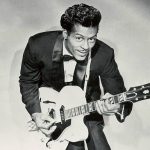
Chuck Berry – Johnny B. Goode
Chuck Berry's "Johnny B. Goode" is an iconic song in the rock 'n' roll genre, widely recognized as a pivotal track in music history. Released in 1958, the song quickly took over the American music scene and had a profound impact on the development of rock 'n' roll. Its catchy melody and innovative guitar riffs influenced many subsequent artists, driving the evolution of rock music. In this article, we will delve deeper into the significance of "Johnny B. Goode" and explore its various aspects.
Song Overview
"Johnny B. Goode" was released as a single by Chuck Berry in 1958 and is also featured on his album After School Session. The song, which Berry wrote and composed himself, represents a quintessential example of rock 'n' roll, with Berry’s guitar playing at the core. The lyrics tell the story of a young boy, Johnny, from a small town who becomes famous for his guitar playing, making him a source of pride for his community. Through the character of Johnny, the song symbolizes the power of music and dreams, a theme that resonates universally while reflecting the youth culture of 1950s America.
One of the song's most appealing aspects is its infectious rhythm and melody. In particular, Berry's guitar riff has become a defining element of rock 'n' roll. The intro riff is simple yet incredibly memorable, and it played a crucial role in establishing the "guitar solo" style in rock music. Through this track, Berry influenced countless future rock guitarists, not only with his technical skill but also with his performance style, which brought a revolutionary energy to live performances.
Songwriting and Production
Chuck Berry wrote and composed the lyrics to "Johnny B. Goode." He is known for his distinctive lyricism and storytelling ability, and he showcased these talents in full force with this song. The lyrics highlight themes of American youth culture and the belief in the power of music, leaving a lasting impression on listeners. Berry sang about a young person chasing his dreams, conveying that music has the power to change lives. This lyrical theme influenced many rock songs that followed, and the idea of music's transformative power continues to be carried forward by many artists.
Berry himself was deeply involved in the production of the song, bringing his vision to life. He ensured that his guitar playing was at the center of the recording process, carefully balancing the overall sound to create an energetic and catchy track. The song not only showcased his incredible talent but also served as an innovative piece in the rock 'n' roll scene of its time. Even today, many guitarists consider it an essential track to perform.
Charts
"Johnny B. Goode" became an immediate hit upon release, reaching number 8 on the Billboard Hot 100. The song's success marked a turning point in Chuck Berry's career, establishing him as a rock 'n' roll icon. Additionally, it topped the R&B charts, expanding its influence across the United States and beyond. The success of this song played a crucial role in the development of rock music, with its impact resonating across generations of artists.
Moreover, "Johnny B. Goode" helped solidify rock 'n' roll as a dominant music genre. Berry's performance style and the song's lyrical content emphasized the connection between youth culture and music. The song’s message remains relevant, making it an essential classic for rock fans around the world, and it continues to be a staple in the genre’s history.
Music Video and Visual Representation
In the 1950s, the concept of music videos as we know them today was virtually nonexistent. However, live performance footage of Chuck Berry playing "Johnny B. Goode" brought the song to life visually, showcasing Berry's dynamic stage presence.
The Back to the Future performance scene effectively functions as a music video for the song, leaving a lasting visual impression on fans and immortalizing the track in pop culture.
Back to the Future | Marty McFly Plays "Johnny B. Goode" and "Earth Angel"
More than 100 million songs in CD quality. 7 million in better-than-CD sound.
🎧 Start your free trial with Amazon Music Unlimited now!
Chuck Berry – Sweet Little Sixteen
Chuck Berry's Sweet Little Sixteen is a classic rock and roll song released in 1958. The lyrics capture the pure romantic feelings and joys of teenage life, while the catchy guitar riffs and driving rhythm make it instantly engaging. Berry's distinctive vocal style and energetic performance made the song a defining anthem of youth culture at the time. It achieved significant chart success and continues to influence countless musicians as a rock classic today.


